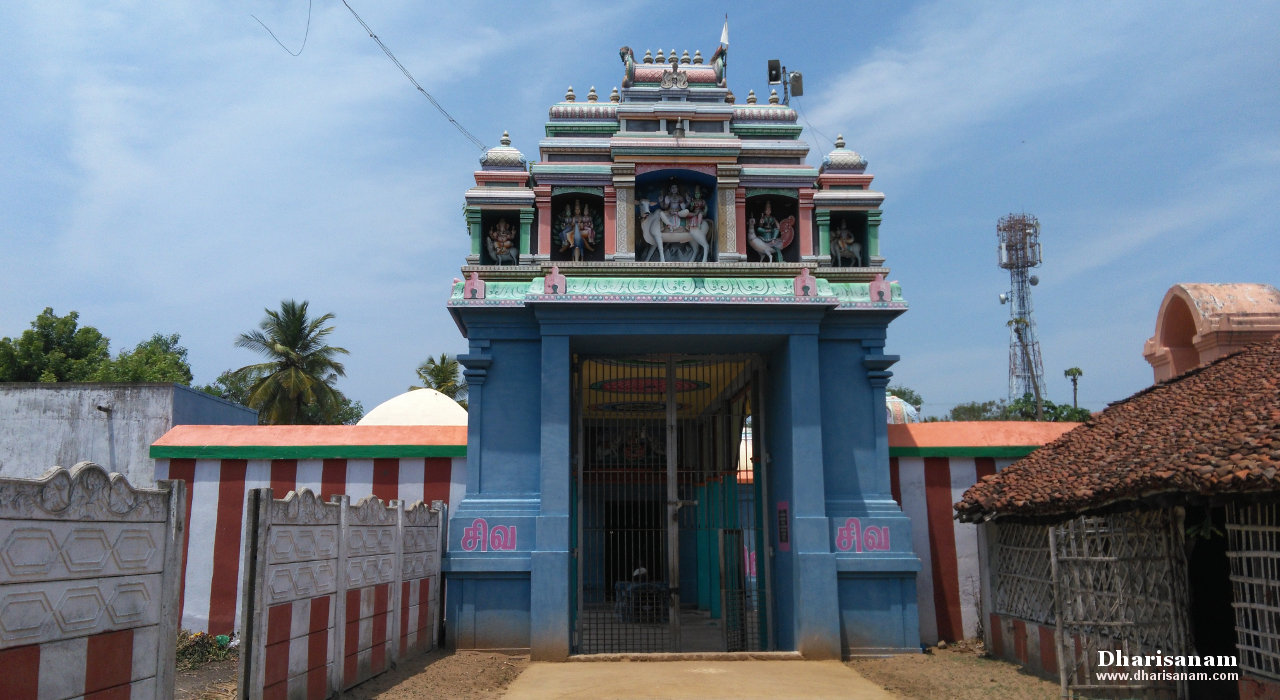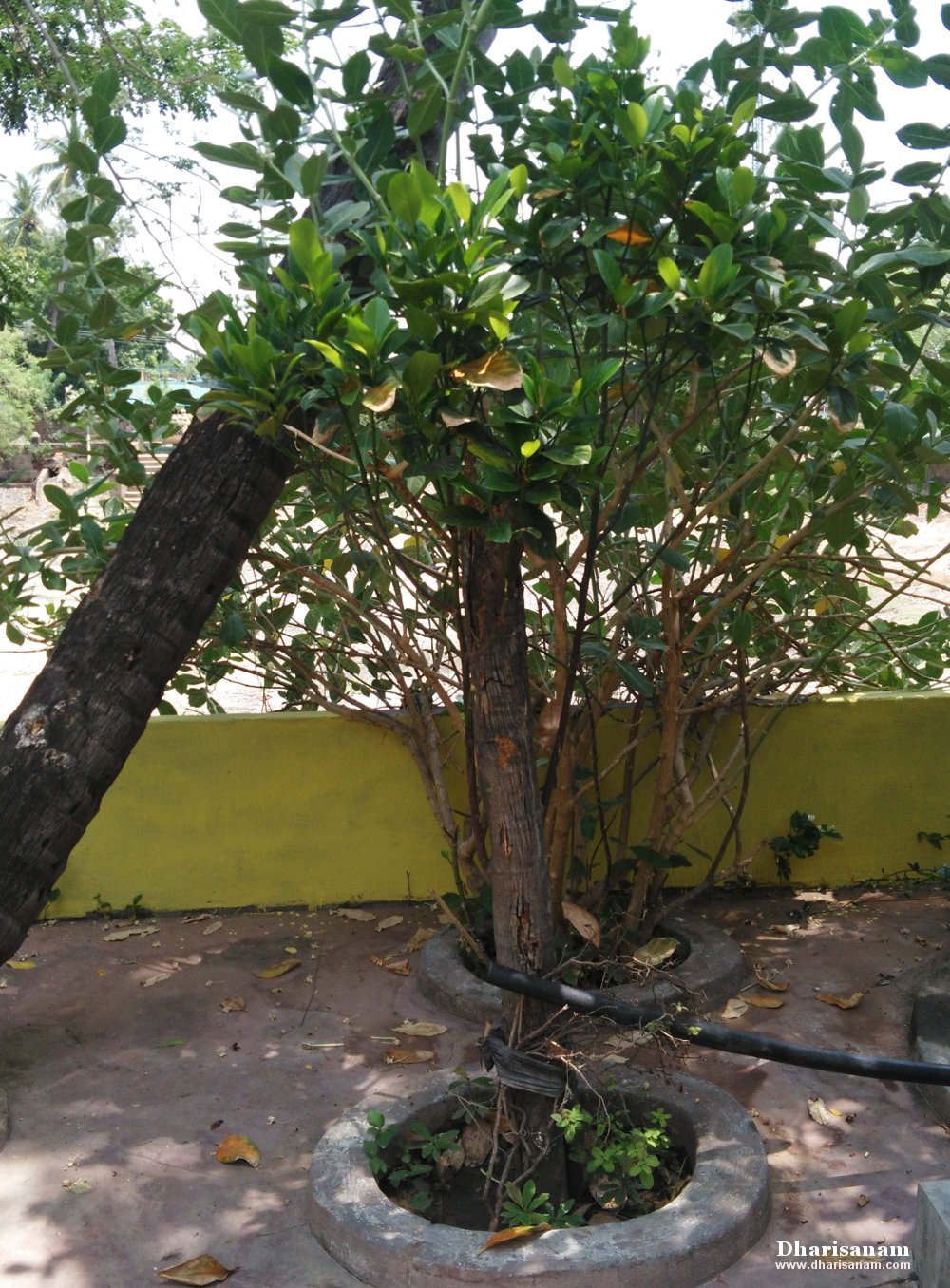Visited on: 15th September, 2018.
Location
Thiruppayatrur is situated at a distance of about 11 kms from Thiruvarur on the Mayiladuthurai to Thiruvarur route. Take the diversion road from Kangalanchery -Nagore road. Reach Melapputhanur and then take the Thiru Marugal road to reach this temple. This temple is 5 kms away from Thiru Marugal.
Other Devara Paadal Petra Shiva Sthalams near this place are –
Thiru Virkudi, Thiru Chengattangudi, Thiru Marugal, Ramanatheecharam, Thiru Pukalur, Thiru Pukalur Varthamaneecharam and Thiru Chathamangai.
General Information
| Moolavar | Sri Payatra Nathar, Sri Payatreeswarar, Sri Mukthapureeswarar |
| Ambal | Sri Kaviyangkanni Ammai, Sri Nethrambigai |
| Theertham (Holy water) | Devi Theertham, Karuna theertham |
| Sthala Vriksham (Sacred Tree) | Silanthi tree |
| Pathigam (Hymn) rendered by | Saint Thirunavukarasar (Appar). |
- This is one of the 276 Devara Paadal Petra Shiva Sthalams and 78th Shiva Sthalam on the Southern bank of the river Cauveri in Chozha Nadu (Thenkarai).
- Lord Shiva in this temple is a Swayambumurthi (self-manifested).
- This east facing temple has a single corridor and its main tower does not have any tiers. In place of the Gopuram, there are beautiful sculptures depicting the “panchamoorthy” (Lord Shiva, Goddess Parvathy, Vinayakar Murugan and Ankarakan).
- This temple has no flag post (“Dwajasthambam”).
- The last consecration ceremony (Maha Kumbabishekam) took place on 06.06.2011 and prior to that on 20.08.1975.
History of the Temple
The historical name of this place is Thiruppayatrur but it is now known as Thiruppayathankudi.
There are some stone inscriptions in this temple which date back to the period of Chola King Rajarajan-II.
One of the stone inscriptions here narrates the story of a man named Panchanathavaanan. He was suffering from some eye diseases and he prayed to the lord for a cure. He was cured of his ailments. His family then donated some land to this temple.
This temple is under the administrative control of the Hindu Religious and Charitable Endowments Department of Government of Tamil Nadu (HR&CE).


Legend
It is believed that Sage Bairava Maharishi worshiped Lord Shiva here.
As per legend, there lived a trader here who was also an ardent Shiva devotee. Nagapattinam, a nearby place, was the import and export hub during that period. Once, he had gone to Nagapattinam to trade some pepper. There was a check-post on the way, and he knew that the pepper that he carried with him would be taxed there. He realised that if he paid the taxes, he would incur a heavy loss. The trader prayed to Lord Shiva asking him to transform his stocks of taxable pepper into tax-free pulses (“Payaru” in Tamil) till such time the inspection at the check-post was complete. The lord fulfilled his wishes. It is believed that the trader spent his profit in renovating this temple. Hence the lord here is praised as Sri Payatru Nathar and the place gets the name Payatrur.
Deities in the temple
Other than the shrines of Lord Shiva and Goddess Parvathy, shrines and idols of Siddhi Vinayakar, Murugan with his consorts, Mahalakshmi, Bairava Maharishi, Maha Ganapathy, Dhandapani, Viswanathar with Visalakshi, Bairavar, Suryan, Chandran, Navagraham, Chandikeswarar and Veeramaakaali can be seen in the hall and the corridors.
In the “koshtam” (place surrounding the sanctum sanctorum), idol of only Dakshinamurthy can be seen.






Salient Features
This temple’s Sthala Viruksham is the Silanthi tree. This tree’s flowers are yellow in colour and resembles a spider.
There is no shrine for Goddess Durgai here but in its place, there is a shrine for Goddess Veeramaakaali.
The peacock idol in front of Lord Murugan looks very beautiful. Also, the idols in the Navagraham are very beautiful.
The front hall (Mandapam) of this temple is designed to look like the forehead of a bat (“Vovval Nethi Mandapam”). This looks very beautiful.
The sanctum sanctorum is in the form of semi-circular tank (“akazhi” in Tamil).



Greatness of this temple
Those suffering from eye related diseases can take a dip in this temple’s Theertham and worship Goddess Kaviyangkanni for relief.
Devotees can worship Goddess Veeramaakaali to ward off evil spirits.
Important Festivals
Brahmotsavam is celebrated in the Tamil month of Vaikasi (May-June) on Visakam star day in a grand manner.
Some of the other important festivals celebrated in this temple are –
Full moon day in the Tamil month of Chithirai (Apr-May),
Aadi Pooram and Fridays in the Tamil month of Aadi (July-Aug),
Vinayakar Chaturthi in the Tamil month of Aavani (Aug-Sept),
Navarathri in the Tamil month of Purattasi (Sept-Oct),
Skanda Shashti and Annabishekam in the Tamil month of Aippasi (Oct–Nov),
Thiru Karthikai in the Tamil month of Karthikai (Nov-Dec),
Makara Sankranthi and all Fridays in the Tamil month of Thai (Jan-Feb) and
Shivrathri in the Tamil month of Masi (Feb-Mar).
Pradosham is also observed regularly.
Temple Timings
From 07:00 AM to 12:00 Noon and from 04:00 PM to 08:30 PM.
Temple Address
Sri Payatrunathar Temple,
Thiruppayatrur (Thiru Payathangudi),
Kangalanchery Via,
Nannilam Taluk,
Nagapattinam District,
Tamil Nadu – 610101.
Tele: +91 – 4366 - 272 423, 98658 44677.
This temple’s priest, Sri Chandrasekara Gurukkal can be contacted at +91 – 96264 76428.






Pathigam (Hymn) with English transliteration and Tamil meaning.
Saint Thirunavukkarasar (Appar) visited this temple and sang this Pathigam.
Devotees visiting this temple should make it a practice to recite this Pathigam.
Pathigam No.4.032.
உரித்திட்டார் ஆனை யின்றோல் உதிரவா றொழுகி யோட
விரித்திட்டார் உமையா ளஞ்சி விரல்விதிர்த் தலக்கண் நோக்கித்
தரித்திட்டார் சிறிது போது தரிக்கில ராகித் தாமுஞ்
சிரித்திட்டார் எயிறு தோன்றத் திருப்பயற் றூர னாரே.
“Uriththiṭṭār āṉai yiṉtṟōl uthiravā ṟozhuki yōṭa
viriththiṭṭār umaiyā ḷañchi viralvithirth thalakkaṇ nōkkith
tariththiṭṭār siṟithu pōthu tharikkila rākith thāmuñ
siriththiṭṭār eyiṟu thōṉtṟath thiruppayat ṟūra ṉārē”.
திருப்பயற்றூர்ப் பெருமானார் குருதிவெள்ளம் ஆறாக ஓட யானையின் தோலை உரித்துத் தம் திருமேனியில் விரித்துப் போர்த்தார். யானைத்தோலை உரித்ததனையும் போர்த்ததனையும் கண்டு பார்வதிதேவியார் அஞ்சித்தம் விரல்களைப் பலகாலும் உதறி வருந்தியதனைக் கண்டு, சிறிதுநேரம் அத்தோலைப் போர்த்தியபின் அவ்வாறு தொடர்ந்து போர்த்தும் ஆற்றல் இல்லாதவரைப் போலக் காட்சி வழங்கித் தாமும் பற்கள்தோன்றச் சிரித்துவிட்டார்.
உவந்திட்டங் குமையோர் பாகம் வைத்தவர் ஊழி யூழி
பவந்திட்ட பரம னார் தாம் மலைச்சிலை நாகம் ஏற்றிக்
கவர்ந்திட்ட புரங்கள் மூன்றுங் கனலெரி யாகச் சீறிச்
சிவந்திட்ட கண்ணர் போலுந் திருப்பயற் றூர னாரே.
“Uvanthiṭṭaṅ kumaiyōr pākam vaiththavar ūzhi yūzhi
pavanthiṭṭa parama ṉār thām malaichchilai nāgam ētṟik
kavarnthiṭṭa puraṅkaḷ mūṉtṟuṅ kaṉaleri yākach chīṟich
sivanthiṭṭa kaṇṇar pōlun thiruppayat ṟūra ṉārē”.
திருப்பயற்றூரனார்பல ஊழிகளையும் படைத்த பெருமானாராய், விரும்பிப் பார்வதிபாகராய், மலையை வில்லாகக் கொண்டு, பாம்பை அதற்கு நாணாகக் கட்டி, உலகங்களில் பலரையும் சென்று பற்றி வருத்திய மும்மதில்களும் தீக்கு இரையாகுமாறு, வெகுண்டு சிவந்த கண்களையுடையவர்.
நங்களுக் கருள தென்று நான்மறை யோது வார்கள்
தங்களுக் கருளும் எங்கள் தத்துவன் றழலன் றன்னை
எங்களுக் கருள்செய் யென்ன நின்றவன் நாகம் அஞ்சுந்
திங்களுக் கருளிச் செய்தார் திருப்பயற் றூர னாரே.
“Naṅkaḷuk karuḷa theṉṟu nāṉmaṟai yōthu vārkaḷ
thaṅkaḷuk karuḷum eṅkaḷ thaththuvaṉ tṟazhalaṉ tṟaṉṉai
eṅkaḷuk karuḷsey yeṉṉa niṉtṟavaṉ nāgam añchun
thiṅkaḷuk karuḷich cheythār thiruppayat ṟūra ṉārē”.
திருப்பயற்றூரனார் நமக்கு அருள்கிட்டும் என்று நான்கு வேதங்களையும் ஓதும் அந்தணர்களுக்கு அவ்வாறே அருள் செய்யும் உண்மைப் பொருளாய்த் தீ நிறத்தவராய் எங்களுக்கு அருள் செய்வீராக என்று எல்லா உயிர்களும் வேண்டித் தொழுமாறு அழியாது நின்ற முதல்வராய்ப் பாம்பினை அஞ்சும் பிறைமதிக்கு அஞ்சவேண்டாதவாறு அருள் செய்துள்ளார்.
பார்த்தனுக் கருளும் வைத்தார் பாம்பரை யாட வைத்தார்
சாத்தனை மகனா வைத்தார் சாமுண்டி சாம வேதங்
கூத்தொடும் பாட வைத்தார் கோளரா மதியம் நல்ல
தீர்த்தமுஞ் சடைமேல் வைத்தார் திருப்பயற் றூர னாரே.
“Pārththaṉuk karuḷum vaiththār pāmparai yāṭa vaiththār
sāththaṉai makaṉā vaiththār sāmuṇṭi sāma vēthaṅ
kūththoṭum pāṭa vaiththār kōḷarā mathiyam nalla
thīrththamuñ chaṭaimēl vaiththār thiruppayat ṟūra ṉārē”.
திருப்பயற்றூரனார் அருச்சுனனுக்கு அருளி, பாம்பினை இடுப்பில் ஆடுமாறு இறுகக்கட்டி, சாத்தனை மகனாக ஏற்றுக் காளிக்காகச் சாமவேதம் பாடியவாறு கூத்து நிகழ்த்திக் கொடிய பாம்பு, பிறை, கங்கை ஆகிய இவற்றைச் சடையில் அணிந்தவராவார்.
மூவகை மூவர் போலும் முற்றுமா நெற்றிக் கண்ணர்
நாவகை நாவர் போலும் நான்மறை ஞான மெல்லாம்
ஆவகை யாவர் போலும் ஆதிரை நாளர் போலுந்
தேவர்கள் தேவர் போலுந் திருப்பயற் றூர னாரே.
“Mūvakai mūvar pōlum mutṟumā netṟik kaṇṇar
nāvakai nāvar pōlum nāṉmaṟai gñāṉa mellām
āvakai yāvar pōlum āthirai nāḷar pōlun
thēvarkaḷ thēvar pōlun thiruppayat ṟūra ṉārē”.
திருப்பயற்றூரனார் அருவம் அருவுருவம் உருவம் என்ற மூவகைப்பட்ட இலயசிவம், போகசிவம், அதிகாரசிவம் என்ற மூவராய், நிறைந்த நெற்றிக்கண்ணராய், முறையாக வைகரி முதலான நால்வகை ஒலிகளை வெளிப்படுத்தும் நாவினை உடையவராய், நான்கு வேதங்கள் சிவாகமம் முதலிய ஞானநூல்கள் என்பவற்றின் வடிவினராய், திருவாதிரை நாளை உகப்பவராய்த் தேவர்களுக்குத் தலைவராய் விளங்குபவராவார்.
ஞாயிறாய் நமனு மாகி வருணனாய்ச் சோம னாகித்
தீயறா நிருதி வாயுத் திப்பிய சாந்த னாகிப்
பேயறாக் காட்டி லாடும் பிஞ்ஞகன் எந்தை பெம்மான்
தீயறாக் கையர் போலுந் திருப்பயற் றூர னாரே.
“Gnāyiṟāy namaṉu māki varuṇaṉāych sōma ṉākith
thīyaṟā niruthi vāyuth thippiya sāntha ṉākip
pēyaṟāk kāṭṭi lāṭum piññakaṉ enthai pem'māṉ
thīyaṟāk kaiyar pōlun thiruppayat ṟūra ṉārē”.
திருப்பயற்றூரனார் தீ நீங்காத கையினராய், தீபங்கள் நீங்காத சுடுகாட்டில் கூத்து நிகழ்த்துபவராய், தலைக்கோலம் அணிந்தவராய், நமக்குத் தந்தையாராய், தலைவராய், ஞாயிறு, சந்திரன்களாகவும், யமன், வருணன், அக்கினி, நிருருதி, வாயு, மேம்பட்ட சாந்த வடிவினனாகிய ஈசானன் ஆகிய எண்திசை காப்போராகவும் உள்ளார்.
ஆவியாய் அவியு மாகி அருக்கமாய்ப் பெருக்க மாகிப்
பாவியர் பாவந் தீர்க்கும் பரமனாய்ப் பிரம னாகிக்
காவியங் கண்ண ளாகிக் கடல்வண்ண மாகி நின்ற
தேவியைப் பாகம் வைத்தார் திருப்பயற் றூர னாரே.
“Āviyāy aviyu māki arukkamāyp perukka mākip
pāviyar pāvan thīrkkum paramaṉāyp pirama ṉākik
kāviyaṅ kaṇṇa ḷākik kaṭalvaṇṇa māki niṉtṟa
thēviyaip pākam vaiththār thiruppayat ṟūra ṉārē”.
திருப்பயற்றூரனார் வேள்வித் தீயின் புகையாய், வேள்வியில் தேவருக்கு வழங்கப்படும் அவி உணவாய், நுண் பொருளாய், மிகப்பெரும் பொருளாய், தீவினை செய்தவருடைய தீவினைகளை எல்லாம் போக்கும் பெருமானாய், பிரமனாய், கருங்குவளைபோன்ற கண்களை உடையளாகிக் கடல் போன்ற நீலநிறம் உடைய பார்வதிபாகராகயும் உள்ளார்.
தந்தையாய்த் தாயு மாகித் தரணியாய்த் தரணி யுள்ளார்க்
கெந்தையு மென்ன நின்ற ஏழுல குடனு மாகி
எந்தையெம் பிரானே என்றென் றுள்குவா ருள்ளத் தென்றுஞ்
சிந்தையுஞ் சிவமு மாவார் திருப்பயற் றூர னாரே.
“Thanthaiyāyth thāyu mākith tharaṇiyāyth tharaṇi yuḷḷārk
kenthaiyu meṉṉa niṉtṟa ēzhula kuṭaṉu māki
enthaiyem pirāṉē eṉtṟeṉ tṟuḷkuvā ruḷḷath theṉtṟuñ
chinthaiyuñ sivamu māvār thiruppayat ṟūra ṉārē”.
திருப்பயற்றூரனார், தந்தையாராய்த் தாயாராய் உலகங்களாய், உலகில் உள்ளார் அனைவருக்கும் தலைவராய், ஏழு உலகங்களில் உள்ள உயிர்களின் செயற்பாட்டிற்கு உடனாய் நின்று இயக்குபவராய், 'எந்தையே! எம்பெருமானே!' என்று தியானிப்பவர்கள் உள்ளத்திலே சிந்தையும் சிந்திக்கப்பெறும் சிவமுமாகி உள்ளவராவார்.
புலன்களைப் போக நீக்கிப் புந்தியை யொருங்க வைத்து
இலங்களைப் போக நின்று இரண்டையும் நீக்கி யொன்றாய்
மலங்களை மாற்ற வல்லார் மனத்தினுட் போக மாகிச்
சினங்களைக் களைவர் போலுந் திருப்பயற் றூர னாரே.
“Pulaṉkaḷaip pōka nīkkip punthiyai yoruṅka vaiththu
ilaṅkaḷaip pōka niṉtṟu iraṇṭaiyum nīkki yoṉtṟāy
malaṅkaḷai mātṟa vallār maṉaththiṉuṭ pōka mākich
chiṉaṅkaḷaik kaḷaivar pōlun thiruppayat ṟūra ṉārē”.
திருப்பயற்றூரனார், சுவை, ஒளி, ஊறு, ஓசை, நாற்றம் என்ற ஐம்புல நுகர்ச்சிகளையும் அடியோடு போக்கி, உள்ளத்தை ஒருவழிப்பட நிலைநிறுத்தி, மூலாதாரம் முதலிய ஆறு ஆதாரங்களையும் கடக்க நான், தான் என்ற இரண்டையும் நீக்கி அவனேதானே ஆகிய அந்நெறியாளராய், மாயை, கன்மம் என்ற மலங்களைச் செயற்படாதவாறு செய்ய வல்ல அடியவர் மனத்திலே இன்பவடிவினராய்ச் சினத்தைவிளைக்கும் பிறவித் துன்பங்களை நீக்கி நிற்பவராவர்.
மூர்த்திதன் மலையின் மீது போகாதா முனிந்து நோக்கிப்
பார்த்துத்தான் பூமி மேலாற் பாய்ந்துடன் மலையைப் பற்றி
ஆர்த்திட்டான் முடிகள் பத்தும் அடர்த்துநல் லரிவை யஞ்சத்
தேத்தெத்தா என்னக் கேட்டார் திருப்பயற் றூர னாரே.
“Mūrththithaṉ malaiyiṉ mīthu pōkāthā muṉinthu nōkkip
pārththuththāṉ pūmi mēlāṟ pāynthuṭaṉ malaiyaip patṟi
ārththiṭṭāṉ muṭikaḷ paththum aṭarththunal larivai yañcath
thēththeththā eṉṉak kēṭṭār thiruppayat ṟūra ṉārē”.
திருப்பயற்றூரனார், சிவபெருமானுடைய கயிலைமலையைக் கடந்து புட்பகவிமானம் போகாதாக, அச்செய்தியைச் சொல்லிய தேரோட்டியை வெகுண்டு நோக்கி, மனத்தான் நோக்கிப் பூமியில் தேரினின்றும் குதித்து விரைந்து கயிலைமலையைப் பெயர்க்க முற்பட்டு இராவணன் அதனைப் பெயர்த்து ஆரவாரம் செய்தபோது மலை நடுங்குதல் கண்டு பார்வதி அஞ்சும் அளவில் அவன் தலைகள் பத்தையும் விரலால் நசுக்கிப் பின் பாடிய தேத்தெத்தா என்ற இசையைக் கேட்டு மகிழ்ந்து அவனுக்கு அருள் செய்பவரானார்.







